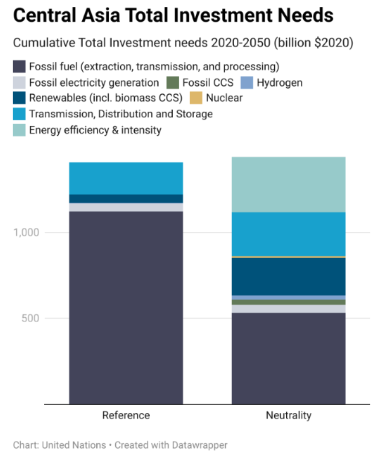Today, fossil fuels account for 95% of total energy supply in the 5 countries of Central Asia - - Kazakhstan, Kyrgyzstan, Tajikistan, Turkmenistan, and Uzbekistan - that are members of UNECE.
A massive shift away from fossil fuels and towards renewable sources will be needed for countries to comply with their obligations under the Paris Agreement and shift to a low-carbon and sustainable energy system.
Analysis published by UNECE as part of its Carbon Neutrality Toolkit shows that under a business-as-usual scenario aiming at strengthening energy resilience to prevent blackouts and ensure reliable supply, the region would need to invest some $1.407 trillion between 2020 and 2050.
However, given the region's high and still largely untapped potential to produce renewable energy, in particular hydro, wind and solar power, the transition to a net-zero scenario by 2050 would only entail a minimal 2.15% increase in overall energy investment over this period of 30 years, to $1.437 trillion.
In other terms, the shift from the current reliance on fossil fuels to net zero would require a significant redirection of investment towards renewables, electricity transmission and distribution, and energy efficiency, but at a marginal additional cost of 0.07% annually.
The Carbon Neutrality Toolkit points at practical solutions to achieve a resilient, sustainable, and carbon-neutral energy future for Central Asia.
UNECE Executive Secretary Olga Algayerova stated, "Our analysis points at the large potential for renewables in the 5 countries of Central Asia. Net zero is within reach of the region by 2050, provided sound policy decisions are made and appropriate incentives are in place to redirect investment. I urge all governments to seize this huge opportunity to honor their climate commitments, while ensuring energy security and creating green jobs."
A largely untapped renewables potential
According to the UNECE Renewable Energy Status Report 2022, Central Asian countries have seen unprecedented growth in renewable power capacity, driven mainly by solar photovoltaic (PV) and wind power additions.
For instance, Kazakhstan had a total of 3.7 GW installed between 2017 and 2021 and added USD 0.8 billion in renewable energy investment in 2019. The country's natural resources and uninhabited land that provide opportunities for large-scale wind and solar power projects to implement its recently adopted Carbon Neutrality Strategy 2060, making it a potential leader in the region's energy transition.
In Kyrgyzstan and Tajikistan over 90% of electricity is generated from hydropower. However, hydropower potential is still largely untapped - Kyrgyzstan uses about 13% and Tajikistan about 5% of their hydro potential - and could be used for domestic supply but also as a source of green energy for neighboring countries.
Investing in a net-zero compatible electricity grid
The Carbon Neutrality Toolkit estimates that the current electricity grids are not designed to support the 75% share of intermittent renewable energy sources in the electricity mix expected by 2050 under the net zero scenario. To achieve this, investments of more than USD 255 billion in electricity grid capacity would be required between 2020 and 2050, along with investments in renewable energy production. This would allow for an improvement of 175% in electricity transmission, distribution, and storage.

In anticipation of the global Climate Ambition Summit in September 2023, UN Secretary General António Guterres has tirelessly called for a dramatic increase in investments in renewable energy worldwide.
Central Asia could embrace the shift towards hydrogen
UNECE's assessment on Sustainable Hydrogen Production Pathways looks at transition towards low-carbon development and establishing a hydrogen economy in Eastern Europe, the Caucasus and Central Asia.
Kazakhstan and Uzbekistan are showing momentum in launching their low-carbon energy transition, drafting national hydrogen strategies and deploying renewable energy. Kyrgyzstan and Tajikistan could potentially use surplus electricity from hydropower plants during summer for intermittent hydrogen production.
Turkmenistan is a major energy - mostly natural gas - exporter towards the EU and China. Since both are actively developing the hydrogen economy, hydrogen could offer an interesting diversification
However, many challenges remain, including the sustainable use of water, which is a feedstock for hydrogen produced from electrolysis and cooling (it is estimated between 59 and 95 liters of water are needed to produce 1 kg of hydrogen); the availability of renewable energy resources required for producing low-carbon electricity; and the critical raw materials required for manufacturing water electrolyzers, wind turbines, and solar panels.
Helping countries deliver
Governments and industry are pooling expertise through UNECE's expert groups to propose steps to scale-up electricity grid capacity for renewable energy, as part of a resilient energy system and increased regional and sub-regional cooperation. These include implementing national action plans in South-Eastern Europe, Eastern Europe, the Caucasus, and Central Asia to accelerate the transition to renewable energy sources and investing in modernizing existing grid infrastructure. Countries are also working together to harness UNECE tools to help secure a sustainable supply of critical raw materials and deploy enhanced energy efficiency measures, which will underpin the electrification of the energy system.
To guide these efforts, the Roadmap to Carbon Neutrality for Europe, North America and Central Asia provides a blueprint for governments to transition to a low-carbon energy system.
Notes
Analysis was made using the MESSAGE model, a framework for energy system planning and scenario development, and preliminary findings applied in the Roadmap to Carbon Neutrality for Europe, North America, and Central Asia as part of the UNECE Carbon Neutrality Toolkit and Technology Interplay under the Carbon Neutrality Concept.
The report aimed to optimize energy systems with the lowest cost to attain carbon neutrality by 2050, considering criteria like local resources, energy security, social welfare, and intergenerational equity. The report was prepared by UNECE experts and consultants and data analysis from the International Institute for Applied Systems Analysis (IIASA), with input from the UNECE Task Force on Carbon Neutrality.






